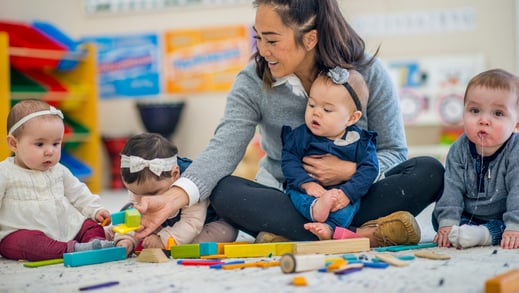
As an infant classroom educator, you know that talking to babies is important. For instance, you tell the infants in your care what they are looking at (“You see the new block basket on the shelf”). You label objects (“You have the red ball”). And you describe events that take place in the classroom (“The tray just fell off the table! That scared you”). These are all examples of talking with babies. Why, then, can it be so challenging to do this consistently in the classroom?
What is Baby Talk?
Educator talk feels natural and comfortable. As we care for infants, we habitually chatter. For example, when we get ready to change a baby’s diaper, we say, “Oh my goodness, you are pretty wet! Let’s grab a fresh diaper and change you!” Or we may say to an infant in a bouncy seat “Wow, look at how many toys are out. I think every toy we have in the classroom is on the floor! I better pick these up before someone trips and falls!” We talk like this quite a bit in infant classrooms.
Then there’s communication support (talk directed at individual infants). We often talk “to” babies. We say things like “Kayden, are you enjoying your pears?” Or sometimes, when a baby says “Ba, ba, ba, ba, ba,” we may say back to the baby “Ba, ba, ba? Do you want your bottle?”
Notice how I said “sometimes?” Talking directly to an infant also feels natural. But we might feel more self-conscious about imitating a baby’s vocalizations back to them.
Finally, there’s communication extension (educators and infant having back-and-forth exchanges). During communication extension, the teacher gives the infants words to say, grabs on to any attempts at sounds an infant makes, and then engages in a back
Why is Baby Talk So Hard?
It feels less natural to extend conversations with an infant. Infants aren’t yet talking, at least not with words. Without words, it's challenging to know what to say to a baby. It’s easier to engage in an extended conversation with a toddler because they are starting to use words and phrases. It’s even easier to engage in a conversation with a chatty preschooler. But a baby? What am I supposed to do?
How to Extend Your Conversations With Infants
What’s the most successful way to converse with a baby? Think “I’m doing the talking for both of us!” The adult is both the supporter and the interpreter of an adult-to-infant conversation. Educators do this by talking to infants, pausing to watch the baby’s reaction, and then interpreting what to say back. Ask yourself, “What might this baby say back to me?” For example:
E: Kayden, are you enjoying your pears?
E: (pauses to watch Kayden’s face while he takes a bite)
K: (takes a bite, and says "mmm")
E: Mmmm. That’s a big bite from your spoon. You like the pears; you think they are pretty tasty.
K: (takes another bite)
E: You are hungry today. Yesterday, you didn’t feel like eating, but today, you are making up for it!
K: (makes a sour face at the next bite)
E: (smiling) Did I remind you how you felt yesterday? You do remember!
Then, continue to watch and listen to Kayden. Keep up the conversation in a natural, back-and-forth fashion until he signals that he is ready to be done.
The above conversation is full of communication support and extension. While filling in both sides of a conversation may feel slightly funny at first, it gets easier over time. Try practicing short conversations throughout the day to increase your comfort level. Before you know it, you’ll be an expert at baby talk!
Editor's note: This post was originally published in September 2017 and has been updated for accuracy and comprehensiveness.

